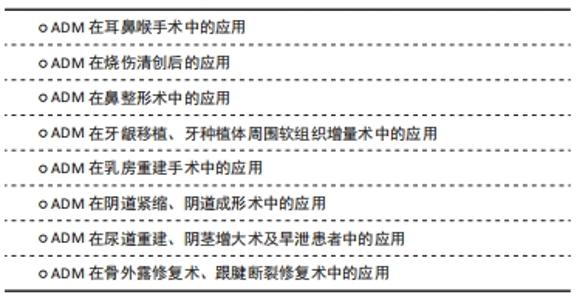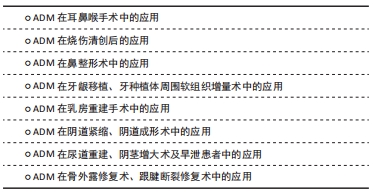Chinese Journal of Tissue Engineering Research ›› 2022, Vol. 26 ›› Issue (34): 5512-5517.doi: 10.12307/2022.471
Previous Articles Next Articles
Clinical application of acellular dermal matrix
Zhu Keying, Guo Rong, Chen Dedian, Huang Sheng
- Third Affiliated Hospital of Kunming Medical University, Kunming 650118, Yunnan Province, China
-
Received:2021-02-19Accepted:2021-03-24Online:2022-12-08Published:2022-04-15 -
Contact:Huang Sheng, Attending physician, Third Affiliated Hospital of Kunming Medical University, Kunming 650118, Yunnan Province, China -
About author:Zhu Keying, Master candidate, Third Affiliated Hospital of Kunming Medical University, Kunming 650118, Yunnan Province, China -
Supported by:the National Natural Science Foundation of China, No. 81860465 (to CDD); the Scientific Research Fund Project of Yunnan Provincial Department of Education, No. 2020J0198 (to GR)
CLC Number:
Cite this article
Zhu Keying, Guo Rong, Chen Dedian, Huang Sheng. Clinical application of acellular dermal matrix[J]. Chinese Journal of Tissue Engineering Research, 2022, 26(34): 5512-5517.
share this article
Add to citation manager EndNote|Reference Manager|ProCite|BibTeX|RefWorks

2.1 ADM的制备及来源 ADM的制备过程主要在于去除产生炎症-免疫反应的免疫原性成分,如细胞DNA、细胞膜脂质、蛋白质成分等,最大限度地保留完整的胶原网状支架[1]。随着现代研究的不断深入,ADM的制作工艺也在不断改进,目前常用的制备方法主要包括DispaseⅡ-Triton、高渗盐水-十二烷基硫酸钠以及反复冻融法配合超声震荡法等方法[5]。 人ADM的临床应用前景广阔,但因其产自新鲜人尸源性而来源匮乏、产量少、价格高,使其使用受到了很大限制,故目前对不同来源ADM的研发也成了一大热点。目前而言,临床上应用较广、开发较完全,并取得较优的临床效果的异种ADM是猪ADM,猪皮来源丰富,处理后与人体皮肤结构、胶原成分含量相似,具有同种异体皮肤绝大部分生物学特性,黏附、止血、减少渗出等方面的性能几乎与人体皮肤相同,因而目前商品化的大部分ADM都为猪皮源性[6]。牛皮来源ADM的研究与开发也在发展过程中,相较人ADM而言,牛ADM来源更广、成本更低,较临床多见的猪ADM而言更适合信仰伊斯兰教患者,有着更广泛的应用空间[7]。美国眼科协会对2018-2019年PubMed收录的眼睑上提术病例报告分析得出,牛ADM是睑挛缩修复很好的植入选择,其短期效果良好,但目前文献中还没有足够的数据显示牛ADM移植物的长期安全有效性[8]。此外,还有羊皮[9]、蛙皮及SD大鼠皮肤等来源的ADM[10-12],天然动物真皮基质因为其丰富的来源和低廉的成本等具有极大临床开发优势,将会有广阔的研究范围及应用前景。 2.2 ADM的特点及优势 ADM能起到真皮支架的作用,与伤口整合后,成纤维细胞和肌成纤维细胞及淋巴细胞、巨噬细胞、粒细胞和肥大细胞均会迅速迁移渗透其中,随之在其内迅速形成结缔组织和新生血管[13-15],ADM具有良好的生物强度,利用其三维支架结构可在细胞增殖过程中发挥支撑、固定、减张、抗拉等作用[16-17]。其次,ADM含有多种信号因子,能对细胞的黏附、增殖、分化及组织形成起促进作用[18],进而提高移植成活率,促进创面恢复。最后,ADM在植入体内后会逐渐降解,逐渐被新生组织替代,相较其他生物材料可以为正常细胞提供足够的生长空间[19],故其可作为良好的组织充填物,尤其新研发出的微粒型ADM,可作为更为方便的注射填充剂[20-22]。 除ADM以外,目前已研制并应用于临床的生物补片种类纷繁,例如猪小肠黏膜下层脱细胞组织基质、牛腹膜、牛马心包、钛化聚丙烯网片、聚丙烯单丝纤维补片及聚丙烯-细胞外基质的杂交材料等[23]。相较ADM,临床常用的生物补片-钛化聚丙烯网片的韧性和强度更高、术后更加稳定,然而因为其材质较硬,伤口愈合慢,且术后术区异物感强烈,质地硬,可因摩擦而致术区疼痛[24]。相较而言,ADM的优点在于质地柔软、易塑形、弹性好、易于缝合,但弊端就是其缺乏张力、强度低、生产成本高、生产工艺复杂、价格昂贵[25]。 2.3 ADM的临床应用"


2.3.1 ADM在耳鼻喉手术中的应用 乳突根治术后易出现肉芽反复生长的情况,导致感染、疼痛、影响听力等问题。刘亚等[26]进行的一项前瞻性非随机对照研究对比了乳突根治术后使用ADM(40例,共45耳)及使用自体组织颞肌筋膜(37例,共40耳)覆盖于手术创面后并发症发生情况,结果表明使用ADM及颞肌筋膜两组术后干耳时间分别为(21.36±5.54),(43.93±12.15) d (P < 0.01),术后术腔完全上皮化时间分别为(27.65±8.19),(56.32±18.62) d (P < 0.01);使用ADM组术后均未发生术腔肉芽增生(0/45,0%),术后6个月时仍发生眩晕者仅有1例(1/40,2.50%);使用自体组织术后术腔呈明显新鲜肉芽增殖者15例(15/40,37.50%),术后6个月时仍发生眩晕者6例(6/37,16.22%)。此项研究表明,使用耳用纤维钳及耳用刮匙摘除肉芽,再将异种ADM贴于创面置于外耳道,可明显加速术腔上皮化,缩短术后干耳时间,减少术后眩晕发生率,同时能减少术腔肉芽及瘢痕形成并维持术后术腔容积稳定,从而降低由于术后肉芽增殖、术腔缩小而导致疾病复发的潜在发生率。 此外,鼻内窥镜被广泛应用于治疗鼻疾病,包括鼻内探查、鼻窦炎和肿瘤等,然而使用内窥镜后刺激鼻腔、瘢痕增生和鼻塞常延迟了鼻黏膜上皮化修复过程。传统促进鼻黏膜修复的方法是进行长时间的鼻腔冲洗。BING等[27]2016年进行了一项前瞻性研究,将31例双侧行鼻腔手术及鼻黏膜修复的慢性鼻窦炎(上颌鼻窦炎、筛窦鼻窦炎)患者鼻腔分为对照组和ADM组,随机选取一侧进行鼻黏膜手术修复,根据每个患者的缺陷选择合适大小的ADM,将脱ADM放置于创面,填充明胶海绵,随访14周后发现ADM组在8周时的Lund-Kennedy评分较对照组显著降低,ADM组上皮化时间为8周左右,显著低于对照组14周的上皮化时间。 腮腺术后会发生弗雷综合征,严重影响患者的生活质量。朱磊[28]进行一项长达9年的临床试验,将行腮腺浅叶部分切除的患者共102例分为2组,对照组46例采用保留腮腺咬肌筋膜的手术方式,ADM组56例保留腮腺咬肌筋膜的同时使用异种脱细胞真皮覆盖创面,随访至少12个月后,采取主观及客观评价方法对患者发生弗雷综合征的情况进行对比发现,结果显示对照组和ADM组的弗雷综合征主观症状发生率分别为34.78%(16/46),5.36%(3/56),客观症状的发生率分别为39.13%(18/46),5.36%(3/56)。故采用ADM植入面神经腮腺区和手术皮瓣之间可以预防弗雷综合征的发生,操作简便,不增加额外的损伤和术区,有效减少及保护面神经受损伤,安全性高且患者容易接受。 2.3.2 ADM在烧伤清创后的应用 烧伤后皮肤挛缩、骨骼畸形等是常见且难以处理的后遗症,尤其手、肘等部位烧伤后功能、活动限制严重影响了烧伤患者的生活质量[29]。GUO等[30]报道了应用刃厚头皮和同种异体ADM联合移植修复6例重度烧伤的患者手深部伤口,术后所有患者均被被成功治疗,一两年的随访中均无复发性掌指关节水泡或背伸畸形,手的形状和功能恢复良好,手功能Carroll评分均在90分以上。因此提示,刃厚头皮与同种异体ADM联合移植是修复重度烧伤患者手深部伤口的好方法,可减轻瘢痕的增生和手部伤口的挛缩,改善烧伤手部的形状和功能。 深Ⅱ度烧伤损伤程度较为严重,波及真皮下毛细血管网,且由于创面长时间暴露于空气中,极易导致感染[31],因此在对深Ⅱ度烧伤患者进行清创时应尽量减少创面暴露时间。ADM黏附性较好,可以为烧伤创面提供生物膜屏障,使用ADM覆盖创面时仅需要在渗透液明显时进行辅料更换,可有效防止多次换药对新生组织造成损伤[32]。ADM可以为创面提供一个较湿润的环境且通透性较好,能够为细胞修复及迁移提供一个良好的无菌环境,从而促进创面愈合,其中所含的胶原可以诱导创面组织细胞增殖聚集,为其提供营养,促进创面自主修复[33]。 2.3.3 ADM在鼻整形术中的应用 在整形外科众多手术中,隆鼻术是一项最为常见的医美手术。对于亚洲人而言,鼻子相对较小且扁平[34],因此亚洲人种的隆鼻手术通常侧重于鼻背部的隆起[35],有学者应用ADM替代常用的硅胶等合成物质或者软骨、脂肪等自体组织作为鼻部填充材料[36]。YANG等[37]对18例使用ADM隆鼻整形术的患者进行了8-38个月的随访,发现所有患者鼻背高度均并未随时间降低,且所有患者均没有严重并发症的发生;总体而言,术后患者ROE问卷满意度得分为81.02(满分100)。这项回顾性研究显示,ADM是鼻整形术中背侧填充的合适替代植入物材料。 2.3.4 ADM在牙龈移植、牙种植体周围软组织增量术中的应用 创伤、细菌、病毒导致牙龈退缩后会出现牙齿敏感、根面磨损及根面龋齿等问题,常需行牙龈移植手术。CEVALLOS等[38]一项长达15年的临床研究对比了ADM与自体游离牙龈移植物15年后牙龈增生的临床结局,发现15年后两种治疗均使角化组织宽度和软组织厚度显著增加,自体游离牙龈移植物组效果更好 (P < 0.05);但总的来说,从美学专业角度来看,ADM牙龈移植术后长期效果更好。两种治疗方法长期观察下来均促进了角化组织宽度和软组织厚度的明显增加,虽然从具体数据来看自体游离牙龈移植物效果更好,但从专业审美观出发ADM更为出色。表明采用ADM 可作为替代传统自提上皮下结缔组织瓣进行加冠向复位瓣术,可在覆盖根面的同时增加软组织厚度及角化宽度,同时消除供区出血等问题,减少手术风险、促进恢复,而且术后的长期观察美学效果较好。 牙种植术是口腔科的一项常见手术,而种植体周围需要有一定宽度的附着龈才能有效预防种植体周围炎的发生,保障种植体修复的长期效果,因此行牙种植术患者常行种植体周围软组织增量手术。种植体周围软组织增量手术的主要目的在于更有效控制菌斑的出现及生长,解除肌肉和系带牵拉、预防牙龈退缩等。LIU等[39]对8例患颌面缺损和牙列缺损患者常规进行牙种植体手术,再将ADM异种移植物和树脂夹板植入,测量无牙区域的唇或颊表面附着的牙龈的宽度,随访3个月后发现患者中附着的牙龈组织宽度从(0.61±0.75) mm显著增加到(6.25±1.04) mm。说明ADM可有效重建种植体周围软组织,明显增加牙龈宽度,术后效果好。 2.3.5 ADM在乳房重建手术中的应用 乳腺癌是全球女性发病率最高的恶性肿瘤,发病率高达11.6%,是在绝大多数国家(145/185个国家)诊断最频繁的癌症,也是100多个国家癌症死亡的主要原因,其死亡率达6.6%[40],传统的乳腺癌手术一般为切除乳房的根治手术,然而切除乳房破坏了人体正常形态,术后的外观改变会对患者的心理及生活质量产生影响,甚至导致心理障碍[41-42]。随着乳腺肿瘤学相关治疗的不断完善,乳腺癌术后的美学形态要求也进一步提升,乳房重建逐渐作为乳腺癌治疗中重要的一环[43]。假体植入乳房重建术的实施需要保留足够容纳并包裹假体的组织。ADM的应用为假体乳房重建组织覆盖问题提出了良好的解决方法。2005年,BREUING等[44]在10例乳腺切除术中使用ADM,疗效良好,这是首次将ADM应用于乳腺手术,通过补片与胸大肌肌瓣构成容纳假体的囊袋,使假体有完整的包裹且无需切取其他组织瓣,手术创伤小。目前已有随机对照试验对比了使用ADM进行二期重建手术及不使用ADM进行一期乳房重建手术的效果,术后1年进行BREAST-Q问卷调查,发现两组患者生理健康、心理健康及性健康评分没有显著差异[45]。 SALZBERG等[46]对863例假体联合补片乳房重建患者进行了平均4.7年的随访,发现所有患者包膜挛缩的累积发生率为0.8%,假体尺寸较小(<400 mL)和术后放疗与包膜挛缩的风险增加显著相关,所有包膜挛缩症均在术后前2年内发展,因此表明使用ADM确实可减少包膜挛缩的发生可能性。 还有研究对比了使用网状ADM与非网状ADM进行乳房重建术后的并发症发生情况,发现使用网状ADM与非网状ADM组发生血清肿、血肿、感染的概率分别为0% vs. 8.2%、0% vs. 4.8%、10.4% vs. 23.8%,引流管拔除时间也明显缩短 2.3 d vs.4.7 d,而两组的包膜挛缩率(5.2% vs. 2.7%)和假体移出率(5.2% vs. 2.7%)相似[47]。因此,与非网状真皮基质相比,使用网状ADM减少了术后血清肿、血肿和感染的发生率,并缩短了引流时间。 2.3.6 ADM在阴道紧缩、阴道成形术中的应用 流产、怀孕、分娩、年龄增长等可导致阴道松弛,随着人们对生活质量的追求,阴道松弛所导致性生活质量降低的问题也得到了重视,私密整形手术逐年增加,近5年增长了近220%[48]。传统阴道紧缩术如阴道黏膜切除紧缩术、会阴体成形阴道紧缩、两侧法阴道紧缩、环形缩紧法、注射缩紧法、激光缩紧法等,常损伤阴道黏膜,出现各种并发症,如术后出血、阴道直肠瘘、术后感觉异常 等[49]。王常印等[50]利用ADM对20例年龄29-48岁有不同程度阴道松弛的患者进行阴道缩紧及会阴加固术,术前所有患者阴道口均可容纳三四指,术后1个半月所有患者阴道只可容纳2指,阴道黏膜无瘢痕;术后随访6个月-1年,患者术后4周开始性生活,18例诉性生活较术前满意,仅2例患者诉术后有轻微疼痛感,可逐渐自行缓解,所有患者均无明显出血、疼痛及直肠、尿道损伤及手术后切口感染等并发症发生。在阴道紧缩术及会阴体加固中使用脱细胞异体真皮,既保留了阴道的弹性,不损伤阴道黏膜,阴道内不遗留瘢痕,损伤小,并发症少,又起到显著紧缩阴道的作用,明显提高性生活质量。 宫颈癌是全球女性发病率第二的肿瘤,发病率为3.2%[40],治疗常规行宫颈癌根治术,根治术后阴道成形术对女性生活质量的改善有重要作用。WANG等[51]使用ADM对16例接受了根治性手术与放疗相结合的早期宫颈癌患者进行了阴道成形术,术后2周内即可观察到人工阴道上皮化;在为时1年的随访中,平均阴道宽度从术前(1.31±0.4) cm显著增加到术后的(4.13±0.43) cm,阴道长度也从(5.97±0.59) cm增加到(9.25±0.66) cm(P < 0.001);大多数患者(12/16)也对重建阴道后的性生活感到满意。此外在阴道成形术中,以往常使用口腔黏膜微颗粒再造阴道黏膜,现有研究表明较单独使用口腔黏膜微颗粒,联合脱细胞同种异体真皮治疗能够有效提高其性功能,改善患者术后性生活质量[52]。因此,ADM也可作为宫颈癌治疗后阴道异常患者行阴道成形术时的一种良好选择,有着强大的应用潜能。 2.3.7 ADM在尿道重建、阴茎增大术及早泄患者中的应用 传统尿道重建术常采用自体皮瓣修复,移植后皮瓣易坏死,且具有无法达到尿道上皮功能性修复等缺点。ADM是一种理想的修复泌尿道缺损或者狭窄的替代材料,可缝合成管状修复被切除的尿道狭窄段,从而完成尿道重建[53],术后尿道造影和膀胱尿道镜显示ADM与周围组织融合良好。于旸等[54]报道了对16例阴茎体型尿道下裂、术后尿道瘘及尿道狭窄儿童的ADM尿道重建手术经验,在36个月的随访中患儿排尿正常,无尿道瘘发生。 对于早泄患者,ADM植入Bucks筋膜下可在阴茎体的皮肤和海绵体之间形成一层组织屏障,能够有效降低阴茎敏感度,从而治疗早泄,尤其是很小阴茎合并早泄的患者[55]。ZHANG 等[56]在2014-2017年对39例早泄患者进行ADM阴茎增大术治疗,术前基线、术后6个月、术后2年随访等的数据表明,术后患者的阴道内射精潜伏时间评分和国际勃起功能评分均较术前提高,早泄症状均较前有所缓解。 张金明等[57]使用ADM填充在阴茎Bucks筋膜与白膜之间加大阴茎,12例小阴茎患者术后自然状态下阴茎周径加大13-31 cm,平均26 cm,术后3个月即可恢复正常的性生活,说明ADM可用于阴茎加大,且该手术创伤小、操作简便、效果好,无不良反应。 2.3.8 ADM在骨外露修复术、跟腱断裂修复术中的应用 人体的某些特殊部位(手指、足趾背侧,胫骨前区、内外踝区及髌骨等)因皮下组织少,损伤后易出现骨、肌腱暴露,造成深部组织的感染、坏死,病情迁延不愈,目前主要以带蒂皮瓣或游离皮瓣对外露创面进行修复[58]。黄波等[59]对11例骨外露患者进行ADM复合自体刃厚皮移植一期修复,10例均完全成活,仅1例因外露创面面积过大出现局部小部分坏死;术后时间短,平均术后愈合时间为(20.73±8.75) d。针对小面积骨外露、周围软组织条件很差、无法行皮瓣转移覆盖的创面,通过同种异体ADM材料复合自体刃厚皮移植行一期修复术能缩短术后修复时间,修复后术区和供皮区瘢痕增生不明显,外观恢复良好。 跟腱断裂是一种好发于运动员及中老年人剧烈运动或长时间不运动突然运动时的外伤[60],跟腱修复术是跟腱断裂的常规治疗方法,然而术后易发生再次断裂的问题。COLE等[61]使用ADM对9例跟腱断裂患者进行了跟腱修复联合补片增强术,术后进行了14.4个月的随访,9例患者的足功能指数平均评分为(33.0±4.2)%,且在观察期内未发生需要进一步治疗的破裂或并发症病例。该结果提示,在跟腱修补后使用ADM覆盖缝合处能发挥增强跟腱的作用,从而降低跟腱断裂的复发率。 此外,关节软骨无血管、淋巴管、神经的结构特点致其再生能力有限,受损后难以自我修复,有体外实验表明,将脂肪来源血管基质成分接种于ADM/生物矿化胶原一体化支架上共培养可以在体外有效支持软骨形成,此结果为关节置换、软骨修复等提供了新启发[62]。"

| [1] SIGALOVE S. Options in Acellular Dermal Matrix-Device Assembly. Plast Reconstr Surg. 2017;140(6S Prepectoral Breast Reconstruction): 39S-42S. [2] LIVESEY SA, HERNDON DN, HOLLYOAK MA, et al. Transplanted acellular allograft dermal matrix Potential as a template for the reconstruction of viable dermis. Transplantation. 1995;60(1):1-9. [3] ALLEN EP. AlloDerm: an effective alternative to palatal donor tissuefor treatment of gingival recession. Dent Today. 2006;25(1):48-50. [4] BREUING KH, WARREN SM. Immediate bilateral breast reconstruction with implants and inferolateral AlloDerm slings. Ann Plast Surg. 2005; 55(3):232-239. [5] 杨荣强,崔正军.异种脱细胞真皮基质临床应用研究与进展[J].中国美容医学,2017,26(9):132-135. [6] SIMPSON AM, HIGDON KK, KILGO MS, et al. Porcine Acellular Peritoneal Matrix in Immediate Breast Reconstruction: A Multicenter, Prospective, Single-Arm Trial. Plast Reconstr Surg. 2019;143(1):10e-21e. [7] FIEDLER DK, BARRETT JE, LOURIE GM. Nail Bed Reconstruction Using Single-Layer Bovine Acellular Dermal Matrix. J Hand Surg Am. 2017; 42(1):e67-e74. [8] TAO JP, AAKALU VK, WLADIS EJ, et al. Bioengineered Acellular Dermal Matrix Spacer Grafts for Lower Eyelid Retraction Repair: A Report by the American Academy of Ophthalmology. Ophthalmology. 2020; 127(5):689-695. [9] WANG L, HAO C, ZHOU B, et al. Application of Heparinized Selective Acellular Sheepskin in Wound-healing Promotion of Deep Second-degree Burns. Wounds. 2016:WNDS20160929-3. [10] RAGHAVAN KV, BABU M, RAJARAM R, et al. Efficacy of frog skin lipids in wound healing. Lipids Health Dis. 2010;9:74. [11] DELAERE PR, HERMANS R. Clinical transplantation of a tissue-engineered airway. Lancet. 2009;373(9665):717-718. [12] 王佳敏,陈菊香.异种脱细胞真皮基质在临床上的应用和开发[J].中华损伤与修复杂志,2019,14(1):71-74. [13] TORK S, JEFFERSON RC, JANIS JE. Acellular dermal matrices: applicationsin plastic surgery. Semin Plast Surg. 2019;33(3):173-184. [14] MUNSTER AM, SMITH-MEEK M, SHALOM A. Acellular allograft dermal matrix:immediate or delayed epidermal coverage. Burns. 2001;27(2): 150-153. [15] SHRIDHARANI SM, TUFARO AP. A systematic review of acelluar dermal matrices in head and neck reconstruction. Plast ReconstrSurg. 2012; 130(5 Suppl 2):35S-43S. [16] SONG Z, YANG D, YANG J, et al. Abdominal wall reconstruction following resection of large abdominal aggressive neoplasms using tensor fascia lata flap with or without mesh reinforcement. Hernia. 2018;22(2): 333-341. [17] GU Y, TANG R, GONG DQ, et al. Reconstruction of the abdominal wall by using a combination of the human acellular dermal matrix implant and an interpositional omentum flap after extensive tumor resection in patients with abdominal wall neoplasm:a preliminary result. World J Gastroenterol. 2008;14(5):752-757. [18] GILPIN A, YANG Y. Decellularization Strategies for Regenerative Medicine: From Processing Techniques to Applications. Biomed Res Int. 2017;2017:9831534. [19] ZHANG X, YANG J, LI Y, et al. Functional Neovascularization in Tissue Engineering with Porcine Acellular Dermal Matrix and Human Umbilical Vein Endothelial Cells.Tissue Eng Part C Methods. 2011;17(4):423-433. [20] SCLAFANI AP, ROMO T 3RD, JACONO AA. Rejuvenation of the aging lip with an injectable acellular dermal graft(Cymetra). Arch Facial Plast Surg. 2002;4(4):252-257. [21] GEURS NC, ROMANOS AH, VASSILOPOULOS PJ, et al. Efficacy of micronizedacellular dermal graft for use in interproximal papillae regeneration. Int J Periodontics Restorative Dent. 2012;32(1):49-58. [22] 黄成,罗旭松.脱细胞真皮基质在组织工程与再生医学中的应用[J].组织工程与重建外科杂志,2020,16(1):65-66. [23] 陈松耀,戴伟钢,陈创奇.生物补片在疝与腹壁外科的临床应用进展[J].中华疝和腹壁外科杂志,2018,12(2):90-93. [24] DIETERICH M, PAEPKE S, ZWIEFEL K, et al. Implant-based breast reconstruction using a titanium-coated polypropylene mesh (TiLOOP Bra): a multicenter study of 231 cases. Plast Reconstr Surg. 2013; 132(1):8e-19e. [25] GSCHWANTLER-KAULICH D, SCHRENK P, BJELIC-RADISIC V, et al. Mesh versus acellular dermal matrix in immediate implant-based breast reconstruction - A prospective randomized trial. Eur J Surg Oncol. 2017; 43(7):1380-1381. [26] 刘亚,崔鑫,刘卓慧,等.异种脱细胞真皮基质在开放式乳突根治术的临床应用[J].昆明医科大学学报,2020,41(3):35-40. [27] BING Z, FENG L, WU CS, et al. Acellular dermal matrix contributes to epithelialization in patients with chronic sinusitis. J Biomater Appl. 2019;33(8):1053-1059. [28] 朱磊.脱细胞基质真皮预防腮腺术后Frey综合征的临床分析[J].全科口腔医学电子杂志,2019,6(7):19-20+25. [29] 吕国忠,许瓅文.重视大面积烧伤早期康复预防后期严重并发症[J].中华烧伤杂志,2017,33(5):257-259. [30] GUO HL, LING XW, LIU ZJ, et al. Split-thickness scalp and allogenic acellular dermal matrix in repairing deep wounds of hands in patients with extremely extensive burns. Zhonghua Shao Shang Za Zhi. 2019; 35(12):876-878. [31] CHAI JK. Diagnosis and comprehensive management of sepsis after burn. Zhonghua Shao Shang Za Zhi. 2013;29(2):105-108. [32] 陆金云.异种脱细胞真皮基质在深Ⅱ度烧伤创面处理中的应用分析[J].浙江创伤外科,2020,25(5):948-949. [33] WAINWRIGHT DJ, BURY SB. Acellular dermal matrix in the management of the burn patient. Aesthet Surg J. 2011;31(7 Suppl):13S-23S. [34] FAKHRO A, WAGNER RD, KIM YK, et al. Milestones of Asian Rhinoplasty. Semin Plast Surg. 2015;29(4):213-218. [35] JANG YJ, YU MS. Rhinoplasty for the Asian nose. Fac Plast Surg. 2010; 26(2):93-101. [36] LEE JH, KIM HG, LEE WJ. Characterization and tissue incorporation of cross-linked human acellular dermal matrix. Biomaterials. 2015;44: 195-205. [37] YANG CE, KIM SJ, KIM JH, et al. Usefulness of Cross-Linked Human Acellular Dermal Matrix as an Implant for Dorsal Augmentation in Rhinoplasty. Aesthetic Plast Surg. 2018;42(1):288-294. [38] CEVALLOS CAR, DE RESENDE DRB, DAMANTE CA, et al. Free gingival graft and acellular dermal matrix for gingival augmentation: a 15-year clinical study. Clin Oral Investig. 2020;24(3):1197-1203. [39] LIU CY, SU YC, TAN BS, et al.Reconstruction of attached soft tissue around dental implants by acelluar dermal matrix grafts and resin splint. Int J Clin Exp Med. 2014;7(12):4666-4676. [40] Bray F, Ferlay J, Soerjomataram I, et al. Global cancer statistics 2018: GLOBOCAN estimates of incidence and mortality worldwide for 36 cancers in 185 countries. CA Cancer J Clin. 2018;68(6):394-424. [41] JANKOWSKA M. Sexual functioning in young women in the context of breast cancer treatment. Rep Pract OncolRadiother. 2013;18(4):193-200. [42] ELDER EE, BRANDBERG Y, BJ RKLUND T, et al.Quality of life and patient satisfaction in breast cancer patients after immediate breast reconstruction: a prospective study. Breast.2005;14(3):201-208. [43] HOWARD MA,POLO K,PUSIC AL,et al. Breast cancer local recurrence after mastectomy and tram flap reconstruction: incidence and treatment options. Plast Reconstr Surg. 2006;117(5):1381-1386. [44] BREUING KH, WARREN SM. Immediate bilateral breast reconstruction with implants and inferolateral Allo Derm slings. Ann Plast Surg. 2005; 55(3):232-239. [45] NEGENBORN VL, YOUNG-AFAT DA. Quality of life and patient satisfaction after one-stage implant-based breast reconstruction with an acellular dermal matrix versus two-stage breast reconstruction (BRIOS): primary outcome of a randomised, controlled trial. Lancet Oncol. 2018;19(9):1205-1214. [46] SALZBERG CA, ASHIKARI AY, BERRY C, et al. Acellular Dermal Matrix-Assisted Direct-to-Implant Breast Reconstruction and Capsular Contracture: A 13-Year Experience. Plast Reconstr Surg. 2016;138(2): 329-337. [47] MAISEL LOTAN A, BEN YEHUDA D, ALLWEIS TM, et al. Comparative Study of Meshed and Nonmeshed Acellular Dermal Matrix in Immediate Breast Reconstruction. Plast Reconstr Surg. 2019;144(5):1045-1053. [48] PLACIK OJ, DEVGAN LL. Female genital and vaginal plastic surgery:an overview. Plastic Reconstructive Surg. 2019;144(2):284e-297e. [49] GARCIA A, BALDONI A. Complex ventral hemia repair with a human acelluar dermal matrix and component separation:a case series. Ann Med Surg(Lond). 2015;4(3):271-278. [50] 王常印,王晓博,韩丽萍,等.脱细胞异体真皮在阴道紧缩术及会阴体加固中的应用效果研究[J].中国美容医学,2020,29(2):27-29. [51] WANG Z, HUANG J, ZENG A, et al. Vaginoplasty with Acellular Dermal Matrix after Radical Resection for Carcinoma of the Uterine Cervix. J Invest Surg. 2019;32(2):180-185. [52] 娄艳红.口腔黏膜、自体皮肤1:2混合微粒联合脱细胞同种异体真皮在阴道再造成形术中的应用[J].临床医学,2020,40(12):53-55. [53] Bonitz RP, Hanna MK.Use of human acellular dermal matrix during classic bladder exstrophy repair. J Pediatr Urol. 2016;12(2):111-114. [54] 于旸,李开升,于嘉智,等.脱细胞异体真皮生物组织补片在小儿尿道重建中的应用[J].中华小儿外科杂志,2012,33(3):236-238. [55] XIN ZC, YANG BC, LI M. Appllication of human acellular dermal matrix in surgical treatment of genitourinary disease. Beijing Da Xue Xue Bao Yi Xue Ban. 2019;51(4):778-782. [56] ZHANG X, WU Y. Acellular dermal matrix in premature ejaculation: A preliminary study. Medicine (Baltimore). 2018;97(45):e13135. [57] 张金明,崔永言,潘淑娟,等.应用脱细胞异体真皮植入Bucks筋膜下加大阴茎[J].中华整形外科杂志,2004,20(6):17-19. [58] 贾玉俊,孙丽琴,杜中宝.带蒂皮瓣术后应用负压封闭引流技术治疗胫骨骨外露创面[J].中国药物与临床,2020,20(18):3045-3046. [59] 黄波,张彦标,李先慧,等.同种真皮基质复合刃厚皮一期修复骨外露创面疗效分析[J].西南军医,2020,22(5):455-458. [60] DORAL MN, ALAM M, BOZKURT M, et al. Functional anatomy of the Achilles tendon. Knee Surg Sports Traumatol Arthrosc. 2010;18:638-643. [61] COLE W, SAMSELL B, MOORE MA. Achilles Tendon Augmented Repair Using Human Acellular Dermal Matrix: A Case Series. J Foot Ankle Surg. 2018;57(6):1225-1229. [62] 陈磊,郑蕊,杰永生,等.脂肪血管基质成分复合骨软骨一体化支架的体外评价[J].中国组织工程研究,2021,25(22):3487-3492. [63] DE HENAU M, KRUIT AS, ULRICH DJO. Reconstruction of full thickness wounds using glyaderm in a single-staged procedure. Cell Tissue Bank. 2021.doi: 10.1007/s10561-021-09907-x.Epub ahead of print. [64] MIRZAYAN R, OTARODIFARD KA, SINGH A. Arthroscopic Superior Capsule Reconstruction with a Doubled-Over (6 mm) Dermal Allograft. Arthrosc Tech. 2021;10(2):e525-e530. |
| [1] | Zhu Chan, Han Xuke, Yao Chengjiao, Zhou Qian, Zhang Qiang, Chen Qiu. Human salivary components and osteoporosis/osteopenia [J]. Chinese Journal of Tissue Engineering Research, 2022, 26(9): 1439-1444. |
| [2] | Zhang Haobo, Zhao Yunan, Yang Xuejun. Role and therapeutic implications of pyroptosis in intervertebral disc degeneration [J]. Chinese Journal of Tissue Engineering Research, 2022, 26(9): 1445-1451. |
| [3] | Jin Tao, Liu Lin, Zhu Xiaoyan, Shi Yucong, Niu Jianxiong, Zhang Tongtong, Wu Shujin, Yang Qingshan. Osteoarthritis and mitochondrial abnormalities [J]. Chinese Journal of Tissue Engineering Research, 2022, 26(9): 1452-1458. |
| [4] | Zhang Lichuang, Xu Hao, Ma Yinghui, Xiong Mengting, Han Haihui, Bao Jiamin, Zhai Weitao, Liang Qianqian. Mechanism and prospects of regulating lymphatic reflux function in the treatment of rheumatoid arthritis [J]. Chinese Journal of Tissue Engineering Research, 2022, 26(9): 1459-1466. |
| [5] | Wang Jing, Xiong Shan, Cao Jin, Feng Linwei, Wang Xin. Role and mechanism of interleukin-3 in bone metabolism [J]. Chinese Journal of Tissue Engineering Research, 2022, 26(8): 1260-1265. |
| [6] | Zhu Chan, Han Xuke, Yao Chengjiao, Zhang Qiang, Liu Jing, Shao Ming. Acupuncture for Parkinson’s disease: an insight into the action mechanism in animal experiments [J]. Chinese Journal of Tissue Engineering Research, 2022, 26(8): 1272-1277. |
| [7] | Guo Jia, Ding Qionghua, Liu Ze, Lü Siyi, Zhou Quancheng, Gao Yuhua, Bai Chunyu. Biological characteristics and immunoregulation of exosomes derived from mesenchymal stem cells [J]. Chinese Journal of Tissue Engineering Research, 2022, 26(7): 1093-1101. |
| [8] | Wu Weiyue, Guo Xiaodong, Bao Chongyun. Application of engineered exosomes in bone repair and regeneration [J]. Chinese Journal of Tissue Engineering Research, 2022, 26(7): 1102-1106. |
| [9] | Zhou Hongqin, Wu Dandan, Yang Kun, Liu Qi. Exosomes that deliver specific miRNAs can regulate osteogenesis and promote angiogenesis [J]. Chinese Journal of Tissue Engineering Research, 2022, 26(7): 1107-1112. |
| [10] | Zhang Jinglin, Leng Min, Zhu Boheng, Wang Hong. Mechanism and application of stem cell-derived exosomes in promoting diabetic wound healing [J]. Chinese Journal of Tissue Engineering Research, 2022, 26(7): 1113-1118. |
| [11] | Huang Chenwei, Fei Yankang, Zhu Mengmei, Li Penghao, Yu Bing. Important role of glutathione in stemness and regulation of stem cells [J]. Chinese Journal of Tissue Engineering Research, 2022, 26(7): 1119-1124. |
| [12] | Hui Xiaoshan, Bai Jing, Zhou Siyuan, Wang Jie, Zhang Jinsheng, He Qingyong, Meng Peipei. Theoretical mechanism of traditional Chinese medicine theory on stem cell induced differentiation [J]. Chinese Journal of Tissue Engineering Research, 2022, 26(7): 1125-1129. |
| [13] | An Weizheng, He Xiao, Ren Shuai, Liu Jianyu. Potential of muscle-derived stem cells in peripheral nerve regeneration [J]. Chinese Journal of Tissue Engineering Research, 2022, 26(7): 1130-1136. |
| [14] | Fan Yiming, Liu Fangyu, Zhang Hongyu, Li Shuai, Wang Yansong. Serial questions about endogenous neural stem cell response in the ependymal zone after spinal cord injury [J]. Chinese Journal of Tissue Engineering Research, 2022, 26(7): 1137-1142. |
| [15] | Xu Lei, Han Xiaoqiang, Zhang Jintao, Sun Haibiao. Hyaluronic acid around articular chondrocytes: production, transformation and function characteristics [J]. Chinese Journal of Tissue Engineering Research, 2022, 26(5): 768-773. |
| Viewed | ||||||
|
Full text |
|
|||||
|
Abstract |
|
|||||